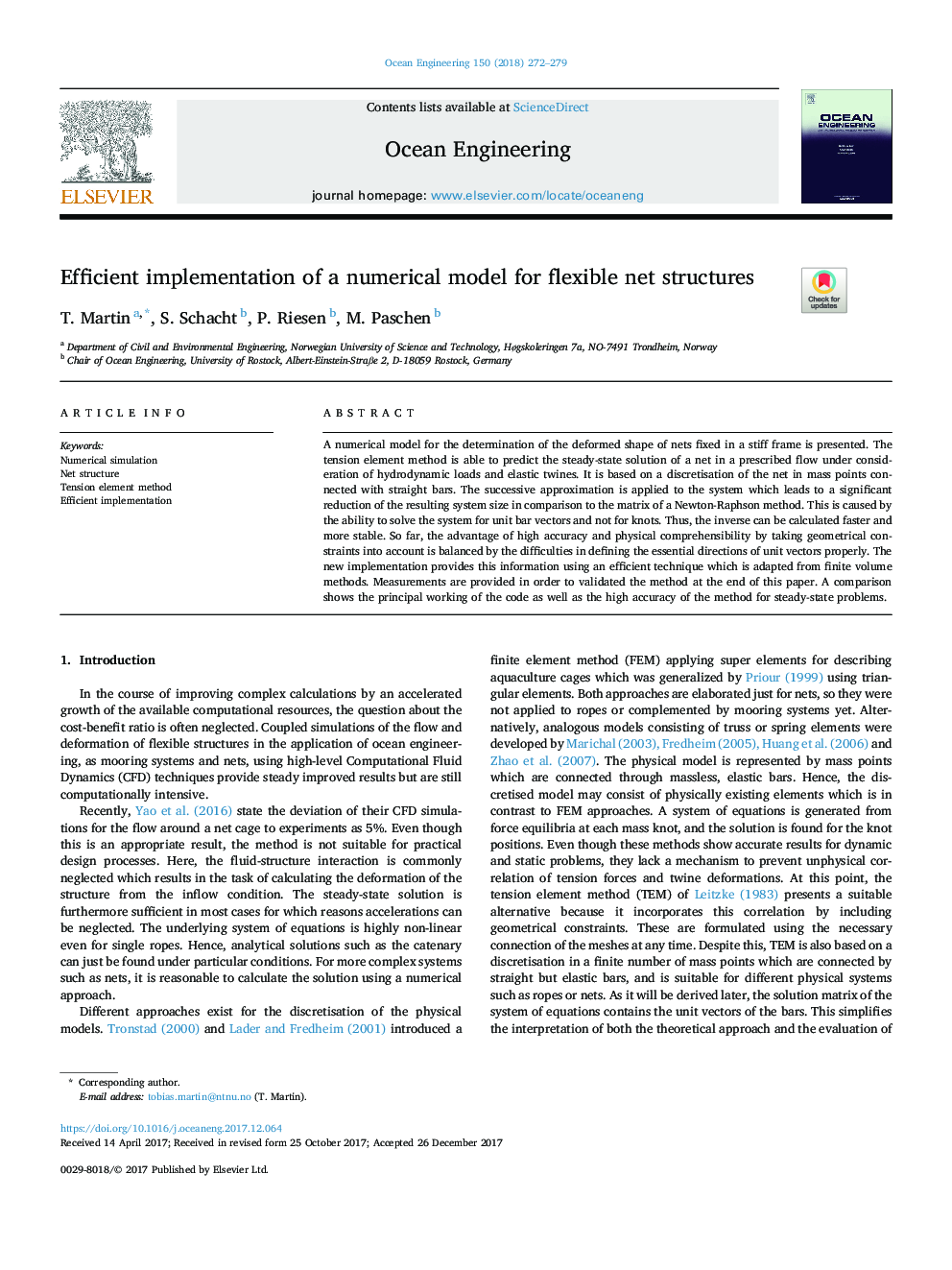| کد مقاله | کد نشریه | سال انتشار | مقاله انگلیسی | نسخه تمام متن |
|---|---|---|---|---|
| 8063408 | 1520640 | 2018 | 8 صفحه PDF | دانلود رایگان |
عنوان انگلیسی مقاله ISI
Efficient implementation of a numerical model for flexible net structures
ترجمه فارسی عنوان
پیاده سازی کارآمد از مدل عددی ساختارهای انعطاف پذیر انعطاف پذیر
دانلود مقاله + سفارش ترجمه
دانلود مقاله ISI انگلیسی
رایگان برای ایرانیان
کلمات کلیدی
شبیه سازی عددی، ساختار خالص، روش المان تنش، پیاده سازی کارآمد،
ترجمه چکیده
یک مدل عددی برای تعیین شکل تغییر شکل شبکه در یک قاب سفت ارائه شده است. روش عنصر تنش قادر به پیش بینی راه حل حالت پایدار یک شبکه در جریان تجدید شده در نظر گرفتن بارهای هیدرودینامیکی و نخ های الاستیک است. این بر مبنای اختلاف شبکهای در نقاط جرمی است که با نوارهای مستطیلی مرتبط است. تقریب متوالی به سیستم اعمال می شود که منجر به کاهش چشمگیر اندازه سیستم در مقایسه با ماتریس روش نیوتن-رافسون می شود. این مسئله به دلیل توانایی حل کردن سیستم برای بردارهای برشی واحد و نه برای گره هاست. بنابراین، معکوس را می توان سریع تر و پایدار تر محاسبه کرد. تا کنون، مزیت دقت بالا و پذیرش فیزیکی با توجه به محدودیت های هندسی به حساب می آید، با مشکلاتی در تعریف مسیرهای اساسی بردارهای واحد به درستی تعمیم می یابد. پیاده سازی جدید این اطلاعات را با استفاده از روش کارآمد ارائه می دهد که از روش های حجم محدود سازگار است. اندازه گیری ها به منظور اعتبار روش در انتهای این مقاله ارائه شده است. یک مقایسه نشان می دهد که کار اصلی کد و همچنین دقت بالا روش برای مسائل حالت پایدار.
موضوعات مرتبط
مهندسی و علوم پایه
سایر رشته های مهندسی
مهندسی دریا (اقیانوس)
چکیده انگلیسی
A numerical model for the determination of the deformed shape of nets fixed in a stiff frame is presented. The tension element method is able to predict the steady-state solution of a net in a prescribed flow under consideration of hydrodynamic loads and elastic twines. It is based on a discretisation of the net in mass points connected with straight bars. The successive approximation is applied to the system which leads to a significant reduction of the resulting system size in comparison to the matrix of a Newton-Raphson method. This is caused by the ability to solve the system for unit bar vectors and not for knots. Thus, the inverse can be calculated faster and more stable. So far, the advantage of high accuracy and physical comprehensibility by taking geometrical constraints into account is balanced by the difficulties in defining the essential directions of unit vectors properly. The new implementation provides this information using an efficient technique which is adapted from finite volume methods. Measurements are provided in order to validated the method at the end of this paper. A comparison shows the principal working of the code as well as the high accuracy of the method for steady-state problems.
ناشر
Database: Elsevier - ScienceDirect (ساینس دایرکت)
Journal: Ocean Engineering - Volume 150, 15 February 2018, Pages 272-279
Journal: Ocean Engineering - Volume 150, 15 February 2018, Pages 272-279
نویسندگان
T. Martin, S. Schacht, P. Riesen, M. Paschen,
